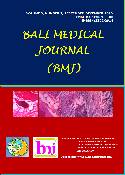PHACOEMULSIFICATION AND SUTURELESS LARGE-INCISION MANUAL CATARACT EXTRACTION CHANGE CORNEAL SENSIBILITY
Abstract
Background: Cataract is the leading cause of blindness worldwide, with surgery as a definitive therapy. Incisions may damage the underlying tissue, including loss of corneal sensibility. The purpose of this study was to determine differences in corneal sensibility decreased in patients after phacoemulsification and SLIMCE. Method: This study was a randomized clinical trial assessing changes of corneal sensibility in immature senile cataract patients after phacoemulsification and SLIMCE at Sanglah and Indera Hospital Denpasar, Bali-Indonesia from March to August 2013. Surgeons and examiners are experienced ophthalmologists. Examiner did not know the initial data subjects. Preoperative assessment of corneal sensibility on the first, eighth, and fifteenth days were assessed postoperative using Cochet-Bonnet aesthesiometer. Statistical analysis was performed by applying mean difference of two independent groups test with repeated measures of multiple comparisons (ANOVA). Samples from each group were 17 eyes. Results: There were significant differences in corneal sensibility on the first day postoperative (33.2 mm), day 8 (-21.5 mm), day 15 (-11.8 mm) in both groups. Decrease in corneal sensibility in both groups was significant (p = 0.001). There was decreasing in corneal sensibility with SLIMCE technique in the first (21.8 mm) and eighth day (45.9 mm). Conclusion: In phacoemulsification technique, corneal sensibility was also decreased in the first (31.8mm) and eighth day (50.6 mm) but returned to preoperative values on day 15 in both groups. Decrease in corneal sensibility during follow-up period is influenced by cataract surgery technique (p = 0.017) and was higher in SLIMCE technique compared with phacoemulsification.


